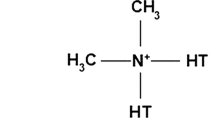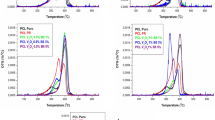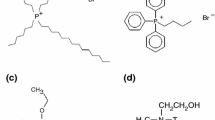Abstract
Nowadays, there is the widespread use of clay minerals as fillers in polymeric materials. One of the most widely used mineral is montmorillonite belonging to the smectite. We have prepared organically modified clays using two different types of accelerators TP and ZDT for sulfur vulcanization. Intercalation of these accelerators into the interlayer of clays was performed using a gas reaction at room temperature. They were examined (characterized) by thermal analysis (DTA, TG), X-ray analysis, and infrared spectroscopy (FTIR).
Similar content being viewed by others
Explore related subjects
Discover the latest articles, news and stories from top researchers in related subjects.Avoid common mistakes on your manuscript.
Introduction
Montmorillonite, with chemical composition (Na, Ca) 0.3 (Al, Mg)2Si4O10 (OH)2·n H2O, is based on two mutually joined silica tetrahedral networks which are connected to octahedral networks of aluminum or silica hydroxide [1]. Tetrahedral and octahedral networks are bound by help of the oxygen atoms on the top, while these oxygen atoms belong to tetrahedrals and octahedrals [2]. Natural smectites can be the most frequently found as heteroionic forms with various interchangeable (inorganic) cations. For laboratory research, it is appropriate to use monoionic forms because they are defined more precisely [3].
The preparation of monoionic form is performed by appropriate cation saturation, and the given cation comes from appropriate aqueous solution of the chloride, nitrate, or acetate [4]. Montmorillonite is a mineral that has to be modified or treated to be used as filler. One of these possible modifications or treatments is closely connected with the intercalation processes which are used to implement the organic compound into the interlayer space of the clay minerals under certain conditions and it includes the cation exchange [5]. In relation to the intercalation of the organic compounds into the interlayer of the clay mineral, the given modification leads to the achievement of such properties which are necessary for application of the mentioned minerals in the function of the nanofiller in polymer nanocomposites [6].
Thermal (TG, DTA), XRD, and spectral (FTIR) analysis are very useful techniques for characterization of organoclays. Various characterization techniques have been used to evaluate structure, morphology, and properties of various materials [6–30].
For instance, XRD technique is based on X-rays and it is suitable for determination of distances of layers of organomodified clays via d(001) basal spacing [31, 32]. Infrared spectroscopy is a powerful method to study the bonding mechanisms on a molecular scale, and it provides structural information about the organoclays [33]. Thermogravimetric analysis (TG) provides the identification of different surfactant environments and structure arrangements and it can be also used for revealing of thermal and structural stabilities [31, 32]. The aims of this work are the systematic studies of fillers based on organoclays in the polymeric materials and also characterized them by thermal, XRD, and spectral analyses.
Experimental
The basic forms (CuMMT and CoMMT) were prepared using aqueous solutions of metal chlorides. After the ion exchange, the resulting solids were washed repeatedly with deionized water until a negative AgNO3 test was obtained. The intercalation of TP and ZDT into CuMMT and CoMMT was carried out by solid–gas reactions.
The materials were characterized by measurements based on XRD, thermal (DTA, TG), and spectral (FTIR) analysis.
X-ray powder diffraction (XRD) patterns were recorded by Philips PW 1050 diffractometer using Cu Kα (0.154 nm) radiation in the region between 2° and 40° (2Θ) at speed 2° min−1.
The thermogravimetry TG and DTA was carried out on a Derivatograph MOM Hungary from room temperature up to 800 °C in air atmosphere at a heating rate of 10 °C min−1.
Infrared absorption spectra were recorded on a FTIR spectrometer tensor 27 in the wavelength range 4,000–400 cm−1 with the resolution of 4 cm−1. The KBr pressed disk technique was used.
Results and discussion
X-ray analysis
Figures 1 and 2 show the X-ray diffraction patterns in the region 3–35° (2Θ) for the monoionic forms of montmorillonite (CuMMT, CoMMT) before and after modification using TP and ZDT. The d(001) value for CuMMT is 12,6 Ǻ and for CoMMT is 15,1 Ǻ.
The interaction between the monoionic forms (CuMMT, CoMMT) and the surfactants (TP, ZDT) led to a shift of the d(001) diffraction peak toward higher 2θ values which imply the constriction of the interlayer spaces due to the surfactant intercalation. Due to a reduction in the interlayer space of clay, parallel arrangement of the intercalated organic molecules between the silicate sheets was observed [34]. It is necessary to point out that the given basal spacing d(001) exhibited lower values in comparison to the initial or staring material.
Thermal analysis
The thermoanalytical curves of the monoionic forms of montmorillonite (CuMMT, CoMMT) before and after modification using TP and ZDT are shown in Figs. 3–5. DTA curves of the basic forms CuMMT and CoMMT show a strong double peak (CuMMT: 129 °C and 196 °C; CoMMT: 139 °C) and this effect reflects the release of water molecules which are located in the interlayer of Cu2+ and Co2+ cations. The dehydroxylation process that is connected with the loss of water results from the decomposition of structural OH groups occurring in 400–800 °C [33]. The overall mass losses are following: CuMMT (20 %) and CoMMT (22 %).
The presence of organic molecules (TP and ZDT) in the monoionic forms of montmorillonite increases the number of decomposition steps. Thermal decomposition of organically modified clays starts with the release of physisorbed water and a small amount of physisorbed TP and ZDT. Endothermic peaks of DTA curves were observed at specific temperatures (CuMMT: 129–138 °C; CoMMT: 126–144 °C). The processes connected with dehydroxylation and thermal decomposition of TP and ZDT in organomodified products are shifted to higher temperatures and it is probably due to strong interaction between accelerators of vulcanization and Cu2+ and Co2+. The overall mass losses of organically modified clays are following: CuMMT + TP (14 %), CuMMT + ZDT (14.1 %), CoMMT + ZDT (18.7 %) and CoMMT + TP (20 %). The values of measured temperatures of DTA for the CuMMT and CoMMT before and after modification are given in Table 1.
FTIR spectroscopy
There are several peaks in the studied region (4,000–400 cm−1) of FTIR spectra of the monoionic forms of montmorillonite (CuMMT, CoMMT), and the given peaks were attributed to the stretching vibrations of OH groups (3626, 3625 cm−1) and water (3441, 3432 cm−1), stretching vibrations of Si–O groups (1025, 1023 cm−1), bending vibrations of AlAlOH (914, 914 cm−1) and AlMgOH (842, 841 cm−1), bending vibrations of Al–O–Si groups (524, 524 cm−1) and Si–O–Si at (465, 465 cm−1) [32–35]. The measured IR spectra of the organically modified MMTs are quite complicated. The significant difference between the monoionic forms of montmorillonite (CuMMT, CoMMT) and the intercalation products can be observed mostly in the region of 2,000–700 cm−1. Spectra of the organically modified CuMMT and CoMMT involve bands in the region 2,958–2,966 cm−1 and it may be assigned to the vibrations of C–H groups. Stretching vibrations of P–O–C groups at 960–1,040 cm−1 and P = S groups at 628–629 cm−1 were observed. The amounts of the absorption bands of the non-modified and organomodified clays are given in Table 2.
Conclusions
The main aim of this work was to prepare and characterize organically modified clays using two types of phosphate surfactants TP and ZDT. Based on the results, it can be concluded that d-spacing was reduced because the molecules of surfactants in the interlayer monoionic forms CuMMT and CoMMT were arranged in a parallel way. The presence of surfactants was also confirmed by IR spectroscopy where presence of the characteristic bands for these organic compounds was recognized and it was also proven by the measurements based on thermal (DTA, TG) and XRD analysis.
References
Paliesková J, Pajtášová M, Feriancová A, Holcová K. The study of fillers on the based organoclays using in the polymeric materials, The 18th Slovak–Polish international scientific conference, machine modeling and simulations, faculty of mechanical engineering, University of Žilina, Slovakia, 2013; 253–255.
Bhattacharyya KG, Gupta SS. Adsorption of a few heavy metals on natural and modified kaolinite and montmorillonite: a review. Adv Colloid Interface Sci. 2008;140:114–31.
Balek V, Beneš M, Šubrt J, Pérez-Rodríguez JL, Sánchez-Jiménez PE, Pérez-Maqueda LA, Pascual-Cosp J. Thermal characterization of montmorillonite clays saturated with various cations. J Thermal Calorim. 2008;92(1):191–7.
Ľalíková S, Pajtášová M, Chromčíková M, Liška M, Šutinská V, Olšovský M, Ondrušová D, Mojumdar SC. Investigation of natural rubber composites with addition of montmorillonite fillers using thermal analysis. J Therm Anal Calorim. 2011;104:969–73.
Li Y, Wang X, Wang J. Cation exchange, interlayer spacing, and thermal analysis of Na/Ca-montmorillonite modified with alkaline and alkaline earth metal ions. J Therm Anal Calorim. 2012;110:1199–206.
Liu Q, Zhang Y, Xu H. Properties of vulcanized rubber nanocomposites filled with nanokaolin and precipitated silica. Appl Clay Sci. 2008;42:232–7.
Leszczynska A, Pieliehowski K. Application of Thermal analysis methods for characterization of polymer/montmorillonite nanocomposites. J Thermal Anal Calorim. 2008;93(3):677–87.
Vasudevan G, Anbusrinivasan P, Madhurambal G, Mojumdar SC. Thermal analysis effect of dopants spectral characterization and growth aspect of KAP crystals. J Therm Anal Calorim. 2009;96:99–102.
Anbusrinivasan P, Madhurambal G, Mojumdar SC. Thermal and spectral properties and induction period, intrafacial energy and nucleation parameters of solution grown anthracene. J Therm Anal Calorim. 2012;108:939–46.
Ramalingam S, Anbusrinivasan P, Periandy S. FT-IR and FT-Raman spectral investigation, computed IR-intensity and raman activity analysis and frequency estimation analysis on 4-chloro-2-bromoacetophenone was—HF and DFT calculations. Spectrochimica Act Part A. 2011;78:826–34.
Mojumdar SC, Raki L. Preparation, thermal, spectral and microscopic studies of calcium silicate hydrate poly(acrylic acid) nanocomposite materials. J Therm Anal Calorim. 2006;85:99–105.
Ezhilvizhi R, Kalainathan S, Bhavannarayana G. Structural and micro hardness studies of urea and thiourea doped glycine phosphate single crystal. Cryst Rev Technol. 2008;43:778–82.
Mojumdar SC. Processing moisture resistance and thermal analysis of MDF material. J Therm Anal Calorim. 2001;64:1133–9.
Madhurambal G, Ramasamy P, Anbusrinivasan P, Vasudevan G, Kavitha S, Mojumdar SC. Growth and characterization studies of 2- bromo-4″- Chloro-acetophenone (BCAP) crystals. J Therm Anal Calorim. 2008;94:59–62.
Mojumdar SC. Thermal properties, environmental deterioration and application of macro-defect –free cements. Res J Chem Environ. 2005;9:23–7.
Madhurambal G, Mojumdar SC, Hariharan S, Ramasamy P. TG, DTA, FTIR and Raman spectral analysis of ZN\Mg, Ammoniumsulphate mixed crystals. J Therm Anal Calorim. 2004;78:125–33.
Selvaraju K, Valluvan R, Kumararaman S. A new metal organic potassium thiourea chloride single crystal. Mat Lett. 2006;440:574–81.
Sawant SY, Verenkar VMS, Mojumdar SC. Preparation, Thermal, XRD, chemical and FT-IR spectral analysis of NiMn2O4 nanoparticles and respective precursor. J Therm Anal Calorim. 2007;90:669–72.
Porob RA, Khan SZ, Mojumdar SC, Verankar VMS. Synthesis TG, DSC and infra-red spectral study of NiMn2(C2H4O4)36N2H4-A precursor for NiMn2O4 nanoparticles. J Therm Anal Calorim. 2006;86:605–8.
Mojumdar SC, Varshney KG, Agarval A. Hybrid Fibrous ion exchange materials past-prevent and failure. Res J Chem Environ. 2006;10:89–103.
Doval M, Palou M, Mojumdar SC. Hydration behavior of C2S and C2ASnanomaterial synthesized by sol-gel method. J Therm Anal Calorim. 2006;86:595–9.
Varshney G, Agarwal A, Mojumdar SC. Pyridine based cerium (IV) phosphate hybrid fibrous ion exchanger synthesis characterization and thermal behavior. J Therm Anal Calorim. 2007;90:731–4.
Mojumdar SC, Melinik M, Jona E. Thermal and spectral properties of Mg(II) and CU(II) Complexes with heterocyclic N-donor ligands. J Anal Appl Pyrrolysis. 2000;53:149–60.
Mojumdar SC, Sain M, Prasad RC, Sun L, Venart JES. Selected thermoanalytical methods and their applications from medicine to construction. J Therm Anal Calorim. 2007;60:653–62.
Mojumdar SC, Simon P, Krutosikova A. [1]Benzofuro[3,2-c]pyridine: synthesis and coordination reactions. J Therm Anal Calorim. 2009;96:103–9.
Mojumdar SC, Miklovic J, Krutosikova A, Valigura D, Stewart JM. Furopyridine-Ni(II) complexes-synthesis, thermal and spectral characterization. J Therm Anal Calorim. 2005;81:211–5.
Mojumdar SC. Thermoanalytical and IR spectroscopy investigation of Mg(II) complexes with heterocyclic ligands. J Therm Anal Calorim. 2001;64:629–36.
Narayanamoolaya B, Dharmaprakash SM. Synthesis, growth and characterization of nonlinear optical crystal l-tyrosine hydrobromide. Cryst Growth. 2006;290:498–503.
Jayalakshmi D, Kumar J. Growth and characterization of bisthiourea Zinc acetate. Cryst Res Technol. 2006;41:37–40.
Mojumdar SC, Mazanec K, Drabik M. Macro Detect Free(MDF) cements: synthesis, thermal, chemical, SEM and Magnetometric study and moisture resistance. J Therm Anal Calorim. 2006;83:135–9.
Kubranová M, Jóna E, Rudinská E, Nemčeková K, Ondrušová D, Pajtášová M. Thermal properties of Co-, Ni- and Cu-exchanged montmorillonite with 3 hydroxypyridine. J Therm Anal Calorim. 2003;74:251–7.
Jóna E, Sapietová M, Šnircová S, Pajtášová M, Ondrušová D, Pavlík V, Lajdová Ľ, Mojumdar SC. Characterization and thermal properties of Ni-exchanged montmorillonite with benzimidazole. J Therm Anal Calorim. 2008;94(1):69–73.
Vavro J, Kianicová M, Vavro J Jr., Vavrová A. Dynamic and thermal analysis for rotor blades of turbo-jet engine TJ 100, 2011. In: Metallurgical journal LXIV. 2011;7:185–188.
Xi Y, Ding Z, He H, Frost RL. Structure of Organoclays—an X-ray diffraction and thermogravimetric analysis study. J Colloid Interface Sci. 2004;277:116–20.
Jóna E, Rudinská E, Sapietová M, Pajtášová M, Ondrušová D, Jorík V, Mojumdar SC. Intercalation of pyridine derivatives into the interlayer spaces of Cu(II)-montmorillonites. Res J Chem Environ. 2005;9(2):41–3.
Acknowledgements
The authors wish to thank the Slovak Grant Agency VEGA for financial support (Grant VEGA: 1/0530/11 and 1/0185/12).
Author information
Authors and Affiliations
Corresponding author
Rights and permissions
About this article
Cite this article
Paliesková, J., Pajtášová, M., Feriancová, A. et al. Thermal properties of fillers based on organoclays in the polymeric materials. J Therm Anal Calorim 119, 939–943 (2015). https://doi.org/10.1007/s10973-014-4109-4
Received:
Accepted:
Published:
Issue Date:
DOI: https://doi.org/10.1007/s10973-014-4109-4









